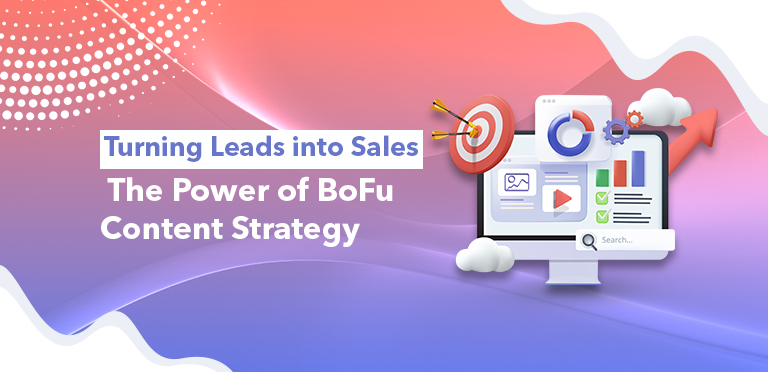Turning Leads into Sales: The Power of BoFu Content Strategy



Every digital marketer or business owner knows that content is a powerful tool in guiding prospects through the sales funnel. At the bottom of the funnel (BOFU), content can act as the final push that converts prospects into customers. This article dives deep into BOFU content, illustrating its pivotal function and illustrating it through select top-grade examples.
Breaking Down BOFU Content
In a sales or digital marketing funnel, TOFU, MOFU and BOFU are the three stages. ‘Top of the Funnel’ or TOFU is the awareness stage, where potential customers first learn about your brand, product, or service. In the ‘Middle of the Funnel’ (MOFU) stage, prospects are considering different options to solve their problem.
BOFU, or “Bottom of the Funnel,” is the last stage before a customer makes a purchase. The goal of BOFU content is to help prospects clear up any final doubts and show them that your solution is the best choice for their needs.
In digital marketing, TOFU, MOFU, and BOFU are all essential for a successful sales funnel, but BOFU is the most critical stage as it focuses on converting prospects from potential customers into actual buyers.
Creating effective bottom-funnel content means understanding what your audience needs and showing how your product or service meets those needs better than others. At this point, people want reassurance that they’re making the right choice. So, it’s important to provide clear, detailed pieces of content about your offerings.
When crafting BOFU content, consider the following tips:
- Convey the Unique Value Proposition: Highlight the distinctive features that set your product apart from competitors.
- Present Authentic Case Studies: Share success stories of clients who benefited from your solution, establishing credibility and building trust with the prospects.
- Offer Interactive Demonstrations or Trials: Giving prospective customers a chance to ‘try before they buy’ enables them to gauge the fit and the value your product presents to their situation.
- Succinctly Address Questions & Concerns: Anticipate and preemptively address remaining queries or friction points that a potential customer might have.
While creating effective BOFU content can indeed be a complex task, it can greatly streamline a prospect’s journey and decision-making process, ultimately setting the stage for conversion and encouraging customer loyalty.
Why is BOFU Content Important?
The relevance of BOFU (Bottom of the Funnel) content cannot be overemphasized in the modern business landscape, as this powerful marketing tool plays a significant role in the customer decision-making process.
How BOFU Content Boosts conversions
At the bottom stage (BOFU) of the marketing funnel, content’s impact lies in its ability to solidify the buying decision, fortify the buyer’s trust, and subtly persuade the prospect to choose your brand over competitors. It thus culminates in increased conversions, reduced sales cycles, and heightened ROI.
Key Benefits of BOFU Content
- Builds trust: High-quality BOFU content can help build trust in your brand. Sharing expert insights, customer testimonies, and positive reviews about your products or services can allure potential customers to trust your brand.
- Supports decision making: BOFU content can help potential customers make buying decisions. Detailed product comparisons, case studies, and product demonstrations provide the necessary information that aids decision making.
- Drives conversions: A well-structured (BOFU) SEO content strategy will lead to a significant increment in conversion rates.
- Improves ROI: Effective BOFU content marketing yields an impressive return on investment.
Top Performing BOFU Content Formats
BOFU or Bottom of the Funnel content is crucial to nudge the prospect towards a purchase decision. It’s crucial to understand that strategic content plays an important role in digital marketing, and having the right combination of content formats can drastically uplift the conversions.
Customer Testimonials, Case Studies, and Product Comparisons are three types of content that are well received in the BOFU stage.
1. Customer Testimonials
Customers testimonials resonate well with the target audience as they provide social proof for the product or service provided. Additionally, this type of content is correlated with higher customer trust seeing that nearly 78% of consumers believe that testimonials are a trustworthy source of information. This content type scores a considerable conversion rate at around 78%, which is quite impressive.
- Testimonials highlight the trust and credibility of the product.
- Authentic testimonials can raise trust by 15-25%.
2. Case Studies
Case Studies provide a realistic and detailed snapshot of the experiences of customers who have benefited from the products or services. This type of content format usually has a high conversion rate of approximately 73%, which suggests that users value transparency and proof of efficiency that case studies provide.
3. Product Comparisons
Product comparisons allow consumers to see how the product or service stacks up against the competition. This can instill confidence in the consumer about the value of the product or service they are considering. The conversion rate for this content format stands around 70%.
- Product comparisons significantly influence the decision-making process.
- Agreeably, 90% of consumers spend time reading online reviews before visiting a business or making a purchase.
BOFU Content Strategy
A well-curated BOFU (Bottom of the Funnel) content marketing strategy is imperative in any effective marketing campaign. It focuses on demonstrating the value of the product or service, reinforcing its Unique Selling Proposition (USP), and reassuring the customer about the investment they are about to make.
This final stage is typically where potential customers are most likely to convert into actual customers, hence, the significance of optimally capitalizing on this stage is crucial.
In streamlining the BOFU content marketing strategy, marketers use pricing pages, personalized consultations, customer testimonials, FAQ (Frequently Asked Questions) sections, case studies, and more. Each of these elements serves a specific purpose in validating the buyer’s decision.
- Pricing Pages: It provides potential customers a detailed overview of various packages, their features, and prices, which aids comparisons and facilitates decision-making.
- Personalized Consultation: This helps to address specific queries, apprehensions, or specific needs of the potential buyers, thereby earning their trust and enhancing personal connection.
- Customer Testimonials & Case Studies: They work as solid proof of product/service efficacy. Positive user experiences influence the buying decisions of prospects.
- FAQ Sections: It quells common doubts or questions buyers potentially have about the product or service.
BOFU Content: Challenges and Solutions
Despite its prominence, producing effective BOFU (Bottom of the Funnel) content can sometimes present challenges. These may range from understanding customer psychology, maintaining personalization, avoiding aggressive sales pitch to gauging content effectiveness. However, with the right strategy and expert guidance, these can be navigated to deliver impactful results.
Understanding Customer Psychology
An understanding of customer psychology is fundamental to the success of BOFU content. However, the challenge lies in accurately interpreting and addressing customers’ values, interests, and buying behaviors. According to a study, 90% of purchasing decisions are made subconsciously, which means that marketers need to tactfully appeal to these subconscious factors.
Maintaining Personalization
As the final leg of the buyer’s journey, BOFU content should feel highly personalized to help foster a relationship with prospects. However, personalizing content for each user might prove challenging, especially with large audiences. In fact, despite the known benefits, only 31% of marketers believe they are effective at personalization (source: eMarketer).
Avoiding Aggressive Sales Pitch
BOFU content should educate the prospect about the potential solutions to their problems without seeming overly sales-oriented. The main challenge here is to strike a balance between providing useful information and promoting the product or service. A recent study suggests that 58% of buyers get turned off by aggressive sales pitches (source: Forbes).
- Maintain a conversational and advisory tone throughout the content
- Share testimonials and case studies to back up product claims
- Provide a comprehensive comparison of your product/service with competitors. This showcases transparency and builds trust among customers.
Gauging Content Effectiveness
The final challenge lies in gauging the effectiveness of BOFU content. This often involves complex measurements and benchmarking conversations and sales against traffic and engagement metrics. As per a HubSpot report, only 22% of businesses are satisfied with their conversion rates, indicating how difficult it is to evaluate the impact of content effectively.
How to Measure the Success of Your BOFU Content
Measuring the success of your Bottom-Of-the-Funnel (BOFU) content is imperative to enhancing and refining your marketing strategy, ensuring you’re effectively achieving your goals and objectives. One may measure this success via certain crucial metrics such as the Customer Acquisition Cost (CAC), Customer Lifetime Value (CLV), conversion rates, and churn rates.
Additionally, there are other metrics that also define success for BOFU content like sales growth, repeat purchases, and customer loyalty. Let’s delve deeper into understanding these indicators.
Key Metrics to Consider
- Customer Acquisition Cost (CAC): This refers to the cost associated with convincing a potential customer to buy a product/service. It is calculated by dividing the total costs spent on acquiring more customers by the number of customers acquired in the period the money was spent.
- Customer Lifetime Value (CLV): This is a prediction of the net profit attributed to the entire future relationship with a customer. It gives an idea of how much revenue a customer can generate for your company over time.
- Conversion Rate: A key measure of your BOFU content’s effectiveness is the frequency with which it leads to a desirable action, such as purchasing a product or signing up for a service. It’s calculated by dividing the number of conversions by the total number of visitors.
- Churn Rate: This involves keeping an eye on the rate at which customers stop doing business with you during a defined period, which helps assess how well you’re maintaining long-term customer relationships.
Conclusion
BOFU content is the final and most crucial step in guiding prospects toward conversion. By offering well-crafted testimonials, case studies, and product comparisons, businesses can establish trust, address concerns, and drive purchasing decisions.
Measuring key metrics such as conversion rates, customer lifetime value, and churn rates ensures that your ‘Bottom of the Funnel’ marketing strategy remains effective and results-driven. A successful marketing strategy relies on crafting targeted TOFU, MOFU, and BOFU content to engage prospects at every stage of the sales funnel.
If you’re looking to enhance your digital content strategy with high-performing BOFU content, Phoenix SEO Ninja can help. Our expert Search Engine Optimization (SEO) services ensure your content reaches the right audience at the right time, maximizing conversions and ROI. Contact us today to elevate your brand’s digital presence and turn prospects into loyal customers!
Frequently Asked Questions (FAQs)
BOFU (Bottom Of the Funnel) content, marks the final stage in the sales funnel where potential customers are on the cusp of making a buying decision. This valuable content is targeted towards nudging them to favor your product or service over competitors.
Effective BOFU content serves as decisive evidence for customers that your product or service best addresses their needs. It facilitates customer decisions, reduces sales cycle duration, maximizes conversions, and enhances marketing ROI.
The BOFU content can take various forms. Customer testimonials, FAQs, product comparisons, case studies, demos, free trials, consultations, onboarding materials, etc., all fall within this category.
Tracking the performance of BOFU marketing content involves analyzing key metrics such as customer acquisitions, churn rates, conversion rates, and Customer Lifetime Value (CLV).
Improving BOFU content involves regular content audits, A/B testing, customer behavior analysis, and engagement monitoring. Strategies should be consistently updated based on what works and what doesn’t.